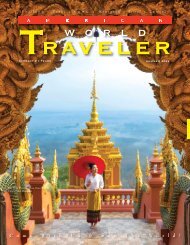Canadian World Traveller Spring 2023 Issue
Now in our 21st year of publishing, Canadian World Traveller explores the culture and history of worldwide destinations, sharing the adventure of discovery with our readers and motivating them to make their travel dreams a reality. Published quarterly, CWT helps sophisticated, independent Canadian travellers choose their next destination by offering a lively blend of intelligent, informative articles and tantalizing photographic images from our World’s best destinations, cruises, accommodations and activities to suit every traveller's taste.
Now in our 21st year of publishing, Canadian World Traveller explores the culture and history of worldwide destinations, sharing the adventure of discovery with our readers and motivating them to make their travel dreams a reality. Published quarterly, CWT helps sophisticated, independent Canadian travellers choose their next destination by offering a lively blend of intelligent, informative articles and tantalizing photographic images from our World’s best destinations, cruises, accommodations and activities to suit every traveller's taste.
You also want an ePaper? Increase the reach of your titles
YUMPU automatically turns print PDFs into web optimized ePapers that Google loves.
39<br />
The 400-year-old street lined with beautifully<br />
sculpted trees has remained unchanged over<br />
the years. And, as our visit was in November,<br />
many Japanese Maple Trees ('Momiji') displayed<br />
spectacular fall colours of yellow,<br />
orange, and red. Historically, Samurai warriors<br />
were stationed in this district to protect<br />
Satsuma Domain from invasion by the neighbouring<br />
Higo Domain. Two of the 150<br />
Samurai residences are open to the public,<br />
and knowledgeable guides provide information<br />
and answer questions.<br />
Nearby, the Izumi-Fumoto History Museum<br />
has an excellent Samurai armour exhibit, but<br />
the most gripping display is a stealthy, lifesized<br />
Samurai archer with a steely look of<br />
concentration on his face as he silently reaches<br />
behind his back to take an arrow from his<br />
quiver.<br />
Following a sunset visit to see how the Cranes<br />
were doing, we returned to our hotel near the<br />
train station and then walked to Uomatsu, a<br />
traditional Izakaya, about 15 minutes away.<br />
The owner, Mieko Matsuki, was very welcoming,<br />
and the food was exceptional. We started<br />
with Kibinago, Silver-stripe round herring,<br />
served sashimi-style with sumiso, a<br />
miso/vinegar dip. This was followed by<br />
chunky, meaty Hagatsuo (Bonito) sashimi.<br />
And cranking up the taste buds even more,<br />
our Kurobuta arrived. This is Japanese Black<br />
Pork, derived from black British Berkshire<br />
Pigs, known for their tender, marbled meat. It<br />
was served in a vegetable stew. So good! And<br />
then, the final dish was presented. Nangoku<br />
genkidori translates as 'south country fine<br />
chicken'. This local Kagoshima Prefecture-<br />
bred chicken was served deep-fried (with<br />
secret herbs and spices!) and was unbelievably<br />
succulent.<br />
The next day, as the sun was rising, we had<br />
one last visit with the Cranes, and then it was<br />
time to head back to the train station for our<br />
onward journey in Kyushu.<br />
Izumi was a great surprise destination with<br />
samurai adventures, exceptional food, warm,<br />
friendly people, and the added thrill of witnessing<br />
one of nature's wonders, the annual<br />
Crane migration.<br />
https://www.izumi-navi.jp/en/<br />
<strong>World</strong> Traveler <strong>Spring</strong> <strong>2023</strong>















